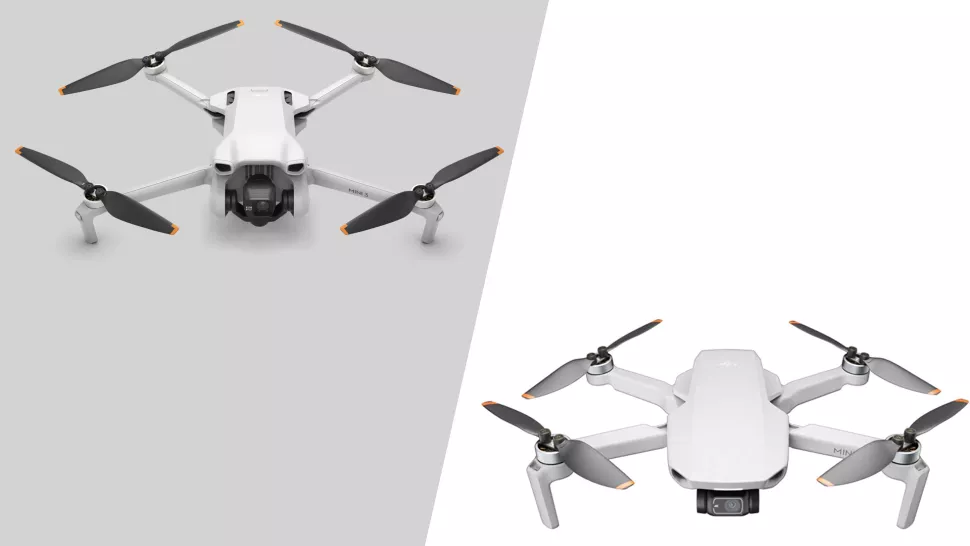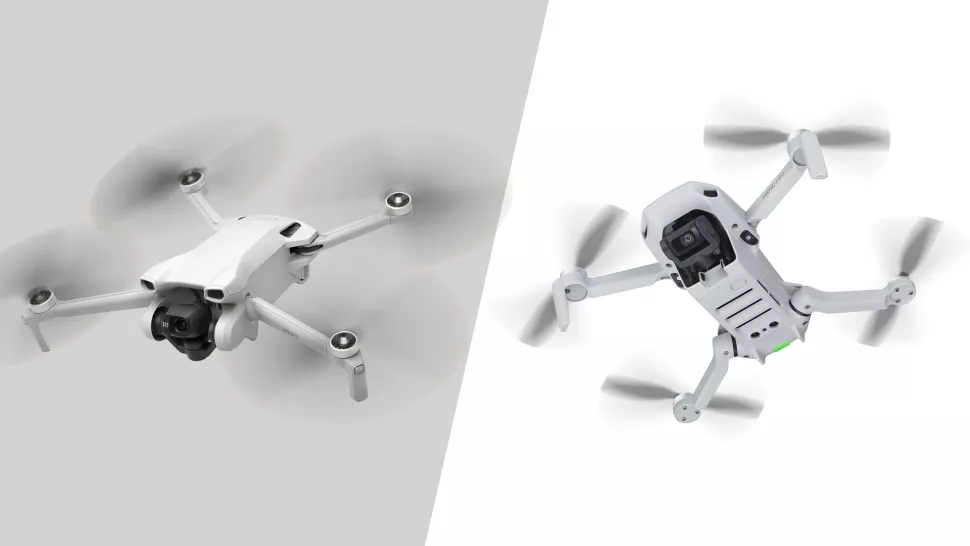in this article we gonna see the DJI Mini 3 vs DJI Mini 2 and come with conclusion which one is better.
The DJI Mini 3 is a drone that is easy to use while producing professional-looking results.
Improvements over the DJI Mini 2 include a new camera sensor and lens, as well as increased flight duration per charge. This also comes with a significant price increase, so some novices may want to look for a DJI Mini 2 offer while they are still available.
The two drones will also have a comparable user experience since, unlike a high-end drone with an extensive sensor system, the DJI Mini 3 simply has downward-facing sensors. This limits out more complex automatic routing options since the drone can’t know whether it’s about to crash into a tree without the necessary sensors.
You’ll need the DJI Mini 3 Pro for those. Nonetheless, as the less expensive option, the DJI Mini 3 appears to be a well-balanced improvement to 2020’s Mini 2.
DJI Mini 3 vs DJI Mini 2: price
The DJI Mini 3 is substantially more expensive than the DJI Mini 2, but DJI has discovered a way to conceal this fact for consumers wishing to upgrade from the previous model.
The drone is $469 / £439 / AU$699 without a controller or charger. This is comparable to the DJI Mini 2’s initial $449 / £419 / AU$749 price. When you add a remote control, the price rises to $699 / £669 / AU$1,019 USD.
| Row 0 – Cell 0 | DJI Mini 3 | DJI Mini 2 |
| With standard controller | $699 / £669 / AU$1,019 | $450 / £420 / AU$750 |
| With Fly More Combo | $559 / £678 / AU$829 | $599 / £549 / AU$949 |
The Fly More Combo, which includes a backpack, charging hub, and two extra batteries, costs $559 / £678 / AU$829 against $599 / £549 / AU$949 for the previous model.
You may also be able to find Mini 2 sets for less money online now that the replacement is available.
Design and controller :
- Both weigh under 250g
- Mini 3 is slightly larger than Mini 2
- Mini 3 doesn’t get the most out of DJI RC
DJI has not just upgraded the Mini 2 shell and some of its components. While there are some similarities, the Mini 3 is obviously a fresh design that has been improved in numerous critical areas.
This was probably essential anyhow, to keep the weight under 250g while changing some fundamental components.
Check also : DJI Mini SE vs DJI Mini 2
Looking at the two shells, you’ll see that the DJI Mini 2 now includes what appear to be light sensors on the front legs. In addition, the housing to the left and right of the camera gimbal is more substantial.
When folded, the DJI Mini 3 is slightly bigger in every dimension, although this is unlikely to matter unless you have a DJI Mini 2 and a very tight-fitting case. In the previous version, a DJI Mini 3 folded down to 138x81x58mm.

Supported remotes varies significantly. The DJI Mini 2 and 3 can both utilize the conventional RC-N1 remote, which lacks an in-built display and a phone clamp. Consequently, packages that contain this remote are available for both drones.
Only the DJI Mini 3 with a 5.5-inch HD screen and a brightness of up to 700 nits supports the DJI RC. This may be brighter depending on the kind of phone you have. Nonetheless, it means you don’t have to secure your phone every time you use your drone.
Nevertheless, the Mini 3 cannot fully utilize the DJI RC’s capabilities because its communication standard can only handle a 720p, 30fps preview, but the remote itself supports up to 1080p, 60 frames per second.
Specs and features :
- DJI Mini 3 has a longer flight time – drastically more with the Plus battery
- The Mini 2 is just as fast as the Mini 3
- Both use the same O2 wireless transmission
One of the primary advantages of the DJI Mini 3 over the previous Mini 2 is its battery life. With the regular battery, it can fly for up to 38 minutes, compared to 31 minutes in the previous drone. With the Intelligent Flight Battery Plus cell, that time climbs to 51 minutes.
This Plus battery is only available in a few areas, but due to the categorization scheme nations utilize, it will push the drone past 250g, which is a massive no-no.
DJI has boosted flying duration by 22%, but battery capacity has only grown by 9% — from 2453mah to 2250mah — implying that it has also made considerable efficiency gains elsewhere.

Yet, this does not convert to faster speeds. Both drones have a horizontal speed of 16 m/s, an ascension speed of 5 m/s, and a descending speed of 3.5 m/s.
They also use the same O2 wireless transmission system, which can connect with the controller from up to 10 kilometers away. This varies on where you operate the drone, but in the United States, it’s 10km.
There is also no improvement in the sensory system’s intelligence. The DJI Mini 2 and Mini 3 include solely downward-facing sensors, rather as the front and rear sensors found on the Mini 3 Pro. This restricts the types of automation that are conceivable. The base micro versions lack the Pro’s MasterShots modes, which are professional-looking automated programs.
Image and video quality
- A larger sensor and a wider lens aperture provide increased natural light sensitivity.
- The Mini 3 includes true vertical filming and HDR footage.
- It also has a more adaptable gimbal mechanism.
DJI has made significant upgrades to the Mini 3’s camera and gimbal technology.
The DJI Mini 2 contains a 12MP camera sensor, whilst the Mini 3 has a significantly bigger 48MP sensor. It has a 1/1.3-inch sensor as opposed to the Mini 2’s 1/2.3-inch sensor, and the lens aperture ranges from f/2.8 to f/1.7.
The Mini 3’s higher natural light sensitivity across the sensor and lens implies it will outperform the Mini 2 at dusk and night. Video is more likely to preserve its colors, have higher detail fidelity, and appear less mushy overall.
We can say this with confidence because the DJI Mini 3 Pro has the same specifications. DJI hasn’t disclosed the specific sensor used in the Mini 3, but we’d assume it’s the same technology as the Pro.
The DJI Mini 3 now has “true vertical shooting,” which we saw on the Pro. This implies that the camera can capture images in the same portrait aspect ratio that you’re likely to employ for certain social media postings.
To achieve that portrait look with a DJI Mini 2, you’d have to drastically cut into the film in post-production.

The gimbal mechanism of the DJI Mini 3 is also more adaptable in another axis. It tilts from -90 to +60 degrees, as opposed to -90 to +20 degrees in the Mini 2.
The Mini 3 can also record HDR video. Because it is sensor-level HDR, it is only accessible at frame rates of up to 30fps, just like the DJI Mini 3 Pro. Two exposures are collected each sensor read-out, reducing ghosting and indicating that this is much more than a software-based tone mapping profile.
The DJI Mini 3 has received a significant improvement, yet several critical components remain same. Both versions of drones capture 4K/30 video. To hit, you must reduce the resolution to 2.7K so you can hit 60 fps.
The Mini 3 Pro can attain 4K resolution at 60fps, implying that DJI has purposefully limited filming settings to keep its products apart. This might, however, be a processor-related difference.
Conclusion
The DJI Mini 3 is mostly what it should be. It improves on the DJI Mini 2 by incorporating some of the hardware upgrades of the Mini 3 Pro without eating the lunch of the more professional-oriented Mini 3 Pro.
Is it worthwhile to upgrade? Perhaps, especially if you want somewhat better image quality in low light or the option to take portrait video to broadcast on social media.
Yet, if you want to improve the quality of your B-roll, you shouldn’t overlook the DJI Mini 3 Pro. Its more powerful sensor system significantly expands the types of looks you may generate with little effort.


